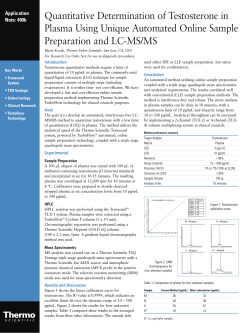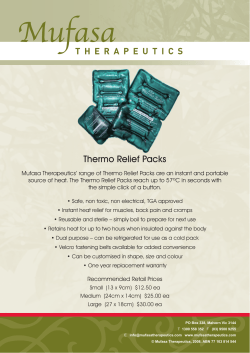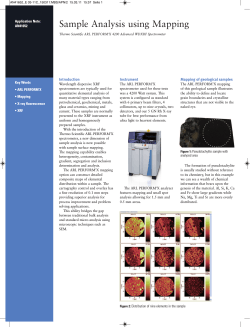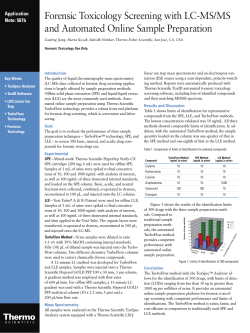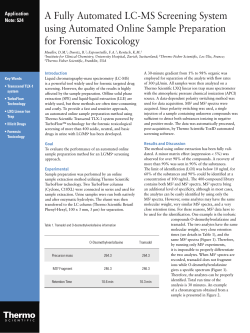
Research Analysis of Clozapine and Norclozapine in Plasma Using Automated
Application Note: 472 Research Analysis of Clozapine and Norclozapine in Plasma Using Automated Sample Preparation and LC-MS/MS Phillip Morgan, Kings College Hospital NHS Foundation Trust, London, UK Shane McDonnell, Sarah Robinson, Thermo Fisher Scientific, Hemel Hempstead, UK TurboFlow™ automated sample preparation technology is being investigated to simplify sample preparation, reduce the risk of operator error, improve sample throughput, and gain further selectivity by utilizing tandem mass spectrometry. Introduction Key Words • TurboFlow Technology • TSQ Quantum Ultra • Clinical Research Clozapine (Figure 1) is a tricyclic dibenzodiazepine drug used in the treatment of schizophrenia. It is uniquely effective in patients resistant to therapy with other antipsychotics. In addition to mandatory hematological monitoring to minimize the risk of agranulocytosis, there are large variations (50-fold) among patients’ clozapine dose requirements. Moreover, changes in smoking habits can have a large effect on the clozapine dose requirement (on average, the clozapine dose for non-smokers is half that required for smokers) due to the induction of cytochrome P450 (CYP) enzymes in smokers.1 Studies have indicated that accurate quantification of clozapine levels may help researchers better understand, and conduct analysis of, issues Figure 1: Structure of clozapine related to dose optimization and adherence.2 Clozapine is metabolized via N-demethylation, N-oxidation, and aromatic hydroxylation, amongst other pathways. A few drugs, notably fluvoxamine, block all four CYP enzymes that can metabolise clozapine. Measurement of N-desmethylclozapine (norclozapine), which accumulates in plasma to concentrations similar to that of clozapine, can give useful information regarding adherence with medication, sample timing in relation to the last dose of clozapine and drug-drug interactions, such as that with fluvoxamine. Current research methodology in our laboratory for clozapine and norclozapine involves off-line liquid-liquid extraction with manual transfer to a high pressure liquid chromatography-ultra violet (HPLC-UV) system. The Thermo Scientific Aria TLX-1 System powered by Goal To assess Thermo Scientific TurboFlow automated sample preparation technology with tandem mass spectrometry for the research analysis of clozapine and norclozapine levels in plasma samples. Experimental Sample Preparation Calibration standards (n=6) were prepared in the range 0.05 mg/L to 2 mg/L by addition of clozapine and norclozapine to newborn calf serum. Similarly, both analytes were added to drug-free human plasma to give internal quality control (IQC) solutions at 0.15, 0.40, and 1.20 mg/L. After centrifugation at 11,000 g for 2 min, 10 µL plasma was injected directly onto the Aria™ TLX-1 system. The eluent gradients for both pumps are displayed in Table 1. TurboFlow LC Column: Mobile phase A: Mobile phase B: Mobile phase D: TurboFlow Cyclone 50 x 0.5 mm 0.05% (v/v) aqueous formic acid 0.05% (v/v) formic acid in methanol 45/45/10 Propan-2-ol/acetonitrile/acetone Analytical LC Column: Mobile phase A: Mobile phase B: Thermo Scientific Hypersil GOLD C18 50 x 2.1 mm, 3 µm 0.05% (v/v) aqueous formic acid 0.05% (v/v) formic acid in methanol TurboFlow Method Analytical Step Start Sec Flow Grad %A %B %C %D Tee Loop Flow Grad %A %B 1 00:00 30 1.50 Step 100 - - - ==== out 0.50 Step 100 0 2 00:30 60 0.25 Step 100 - - - T in 0.25 Step 100 0 3 01:30 60 1.50 Step - - - 100 ==== in 0.50 Ramp 5 95 4 02:30 60 1.50 Step 70 30 - - ==== in 0.50 Step 5 95 5 03:30 60 1.50 Step 100 - - - ==== out 0.50 Step 100 0 Table 1: Gradient programs for both TurboFlow and analytical methods (flow rate is mL/min) Mass Spectrometry Thermo Scientific TSQ Quantum Ultra triple stage quadrupole mass spectrometer Ion Source & Polarity: APCI, positive ion mode Discharge Current: 4.0 µA Vaporizer Temperature: 325 °C Sheath Gas: 60 units Ion Sweep Gas: 0 units Auxillary Gas: 10 units Capillary Temperature: 275 °C Collision Gas Pressure: 1.5 mTorr Figure 2: Extracted ion chromatogram of the plasma blank The selective reaction monitoring (SRM) transitions used are presented in Table 2. Analyte Parent Product Scan Time Collision Energy Tube Lens Clozapine 327.20 192 270 25 ms 25 ms 60 21 47 47 Norclozapine 313.20 164 192 25 ms 25 ms 67 41 113 113 Table 2: SRM transitions monitored in the experiment Results and Discussion Plasma was centrifuged prior to analysis. Calibration standards were analyzed from low to high concentration followed by IQCs. An injection of solvent after the highest concentration IQC was used for evaluation of carryover. The volume of plasma injected was 10 µL, and all plasma analyses were in triplicate. The extracted ion chromatograms of the plasma blank and lowest and highest concentration calibrators are presented in Figures 2, 3, and 4, respectively. The calibration curves for clozapine and norclozapine covered the range 0.05- 2.00 mg/L (Figure 5 and 6). No internal standard was used, and thus, this work demonstrates the reproducibility of the system using external standard calibration. Reproducibility and variance of the calibrators are shown in Figure 7. Carry-over was calculated by comparing the response for clozapine and for norclozapine with that of a solvent blank injected immediately after a 1.2 mg/L IQC sample. This was shown to be ~0.1% for both clozapine and norclozapine. Additional clozapine metabolites were not investigated as part of this evaluation. Figure 3: Clozapine and Norcloxapine lowest calibration from plasma, 0.05 mg/L Figure 4: Clozapine and norcloxapine lowest calibration from plasma, 2 mg/L Conclusion The research use of TurboFlow technology for automated sample preparation and tandem MS detection allowed the selective analysis of clozapine and norclozapine in plasma. The only sample preparation was the centrifugation of plasma. The sample volume required was onetenth that used by the existing method – liquid-liquid extraction (LLE) followed by HPLC-UV – and provided lower limits of detection and quantitation. The calibration curves for all analytes were linear over the concentration range and carry-over was minimal. Use of the automated TurboFlow method has effectively eliminated two hours of sample preparation time for a 100-sample batch. Figure 5: Clozapine calibration curve, 0.05 – 2 mg/L References In addition to these 1. Rostami-Hodjegan A, Amin AM, Spencer EP, Lennard MS, Tucker GT, Flanagan RJ, J Clin Psychopharmacol 2004; 24 (1): 1-9 offices, Thermo Fisher 2. Flanagan RJ, CPD Clin Biochem 2006; 7 (1): 3-18 Scientific maintains a network of representative organizations throughout the world. Figure 6: Norclozapine calibration curve, 0.05 – 2 mg/L Clozapine Concentration Response Norclozapine Specified Conc Calculated Conc % CV 0.05 mg/L 0.05 mg/L 0.05 mg/L 0.10 mg/L 0.10 mg/L 0.10 mg/L 0.20 mg/L 0.20 mg/L 0.20 mg/L 0.50 mg/L 0.50 mg/L 0.50 mg/L 1.00 mg/L 784733 797712 780137 1415271 1456027 1411624 2745962 2743289 2832044 6889405 6682781 6549395 12624439 0.05 0.05 0.05 0.10 0.10 0.10 0.20 0.20 0.20 0.50 0.50 0.50 1.00 0.03 0.03 0.03 0.08 0.09 0.08 0.20 0.20 0.20 0.55 0.54 0.52 1.05 1.2 1.2 1.2 1.7 1.7 1.7 1.8 1.8 1.8 2.6 2.6 2.6 2.3 1.00 mg/L 1.00 mg/L 2.00 mg/L 2.00 mg/L 2.00 mg/L 12261014 12054848 24055429 22868295 23457123 1.00 1.00 2.00 2.00 2.00 1.02 1.00 2.03 1.93 1.98 2.3 2.3 2.5 2.5 2.5 Concentration 0.05 mg/L 0.05 mg/L 0.05 mg/L 0.10 mg/L 0.10 mg/L 0.10 mg/L 0.20 mg/L 0.20 mg/L 0.20 mg/L 0.50 mg/L 0.50 mg/L 0.50 mg/L 1.00 mg/L 1.00 mg/L 1.00 mg/L 2.00 mg/L 2.00 mg/L 2.00 mg/L Response 905801 897792 900825 1555897 1554377 1525338 2847998 2859029 3006773 7099512 6741516 6420812 12521697 12383684 11695815 23888229 22259134 23241437 Specified Conc Calculated Conc % CV 0.05 0.05 0.05 0.10 0.10 0.10 0.20 0.20 0.20 0.50 0.50 0.50 1.00 1.00 1.00 2.00 2.00 2.00 0.04 0.04 0.04 0.10 0.10 0.10 0.21 0.21 0.22 0.57 0.54 0.51 1.04 1.02 0.97 2.01 1.87 1.95 0.4 0.4 0.4 1.1 1.1 1.1 3.1 3.1 3.1 5.0 5.0 5.0 3.6 3.6 3.6 3.5 3.5 3.5 Figure 7: Clozapine/Norclozapine reproducibility and variance Africa-Other +27 11 570 1840 Australia +61 2 8844 9500 Austria +43 1 333 50 34 0 Belgium +32 2 482 30 30 Canada +1 800 530 8447 China +86 10 8419 3588 Denmark +45 70 23 62 60 Europe-Other +43 1 333 50 34 0 Finland / Norway / Sweden +46 8 556 468 00 France +33 1 60 92 48 00 Germany +49 6103 408 1014 India +91 22 6742 9434 Italy +39 02 950 591 Japan +81 45 453 9100 Latin America +1 608 276 5659 Middle East +43 1 333 50 34 0 Netherlands +31 76 579 55 55 South Africa +27 11 570 1840 Spain +34 914 845 965 Switzerland +41 61 716 77 00 UK +44 1442 233555 USA +1 800 532 4752 www.thermo.com For Research Use Only. Not for use in diagnostic procedures. Legal Notices ©2009 Thermo Fisher Scientific Inc. All rights reserved. All trademarks are the property of Thermo Fisher Scientific Inc. and its subsidiaries. This information is presented as an example of the capabilities of Thermo Fisher Scientific Inc. products. It is not intended to encourage use of these products in any manners that might infringe the intellectual property rights of others. Specifications, terms and pricing are subject to change. Not all products are available in all countries. Please consult your local sales representative for details. View additional Thermo Scientific LC/MS application notes at: www.thermo.com/appnotes Thermo Fisher Scientific, San Jose, CA USA is ISO Certified. AN63132_E 11/09M Part of Thermo Fisher Scientific
© Copyright 2025

